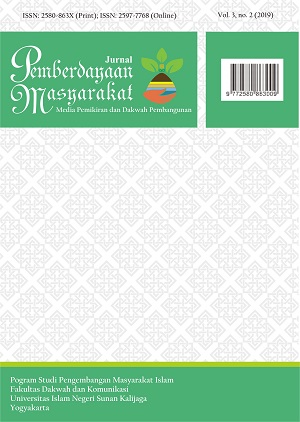Model Pengelolaan Sampah di Kelompok Paguyuban Peduli Sampah Kalibeber Wonosobo
DOI:
https://doi.org/10.14421/jpm.2019.032-10Keywords:
waste, management model, the group of paguyuban peduli sampah Kalibeber.Abstract
This article discusses two important studies. First, the way the Kalibeber Wonosobo community handles waste. Second, the model of waste management in the Kalibeber Wonosobo group. This research uses a Participatory Action Research approach. This approach involves the Kalibeber community as an object and subject as well as to deal with waste. The results of this study show two important scopes. First, the Kalibeber Wonosobo community has an initiative to deal with waste. The initiative emerged because the community felt the environment was dirty, the river water flow was obstructed, and many sufferers of itching. Second, the waste management model uses decentralization. Waste management is carried out in each sub-area to be able to reuse waste (recycling). This discourse is different from other studies. The most prominent differentiating side is the active role of the community by being able to separate organic and inorganic waste. The community operates independently with a voluntary financing mechanism.
Artikel ini membahas dua kajian penting. Pertama, cara masyarakat Kalibeber Wonosobo menangani sampah. Kedua, model pengelolaan sampah kelompok paguyuban peduli sampah Kalibeber Wonosobo. Penelitian ini menggunakan pendekatan Participatory Action Research. Pendekatan ini melibatkan masyarakat kalibeber sebagai obyek dan subyek sekaligus untuk menangani sampah. Hasil penelitian ini menunjukan dua cakupan penting. Pertama, masyarakat Kalibeber Wonosobo memiliki inisiatif untuk menangani sampah. Inisiatif muncul karena masyarakat merasakan lingkungan kotor, aliran air sungai terhambat, dan banyak penderita penyakit gatal-gatal. Kedua, model pengelolaan sampah menggunakan desentralisasi. Pengelolahan sampah ini dilakukan pada setiap sub area untuk bisa memanfaatkan kembali sampah (daur ulang). Diskursus ini berbeda dengan kajian lain. Sisi pembeda yang paling menonjol, antara lain peran masyarakat yang aktif dengan mampu memisahkan sampah organik dan anorganik. Masyarakat bergerak mandiri dengan mekanisme pembiayaan secara sukarela.
 Abstract viewed: 1186 times
|
Abstract viewed: 1186 times
|
 PDF downloaded = 834 times
PDF downloaded = 834 times
 Untitled downloaded = 0 times
Untitled downloaded = 0 times
 Untitled downloaded = 0 times
Untitled downloaded = 0 times
References
Afandi, Agus, Modul Riset Transformatif, 1st edn (Sidoarjo: Dwiputra Pustaka Jaya, 2017)
Al, Sahil Jailan et, ‘Sistem Pengelolaan dan Upaya Penanggulangan Sampah di Kelurahan Dufa-Dufa Kota Ternate’, Jurnal Bioedukasi 4, no. 2 (2016) <https://ejournal.unkhair.ac.id/index.php/bioedu/article/view/160>
Ali, Mukti dan saipullah Hasan, ‘A’wah Bi Al-Hal in the Empowering of Campus-Assisted Community through Management of Garbage Banks’, Jurnal Ilmu Dakwah 13, no. 2 (2019) < https://doi.org/10.15575/idajhs.v13i2.6441>
All, Elamin Muhammad Zamzami et, ‘Analisis Pengelolaan Sampah Pada Masyarakat Desa Disanah Kecamatan Sereseh Kabupaten Sampang’, Jurnal Kesehatan Lingkungan 10, no. 4 (2001) < http://dx.doi.org/10.20473/jkl.v10i4.2018.368-375>
Brigita Gladys, Benno Rahardyan, ‘Analisa Pengelolaan Sampah Makanan di Kota Bandung”, Jurnal Teknik Lingkungan’, Jurnal Teknik Lingkungan ITB 19, 1(2013) <https://ftsl.itb.ac.id/wp-content/uploads/sites/8/2018/06/4.-Gladys-Brigita-dan-Benno-Rahardyan.pdf>
Chandra, Budiman, Pengantar Kesehatan Lingkungan (Jakarta: Penerbit buku kedokteran EGC, 2007)
Ciptakaya, SNI 19-2454-2002, 1st edn (Bandung: Yayasan LPMB, Depertemen Pekerjaan Umum, 2002) <http://ciptakarya.pu.go.id/plp/upload/peraturan/SNI_19-2454-2002_Tata_Cara_Teknik_Operasional_Pengelolaan_Sampah_Perkotaan.pdf>
Daniel, Valerina, Easy Green Living, 1st edn (Bandung: Hikmah, 2009)
Hasan, Saipullah, ‘Model Komunikasi Program CSR Pemberdayaan Wirausaha Muda Pada Perusahaan Migas’, Interdisciplinary Journal of Communication 3, no. 1 (2018) <https://doi.org/10.18326/inject.v3i1.59-82>
Hasan, Saipullah dan Devy Andriany, Pengantar CSR; Sejarah, Pengertian Dan Praksis, 1st edn (Yogyakarta: Pustaka Pelajar, 2015)
Kompas.com/rosyid, ‘Indonesia-Penyumbang-Sampah-Plastik-Terbesar-Kedua-Di-Dunia’, Kompas, 2018
Muhamad, Rizal, ‘Analisis Persolan Persampahan Perkotaan; Studi Kasus Pada Kelurahan Boya Kecamatan Ba Nawa Kabupaten Dongala’, Jurnal Smartek 9, no. 2 (2011) <http://jurnal.untad.ac.id/jurnal/index.php/SMARTEK/article/view/614>
Nilam, Sari Putri, ‘Analisis Pengelolaan Sampah Padat di Kecamatan Banuhampu Kabupaten Agam’, Jurnal Kesehatan Masyarakat Andalas 10, no. 2 (2016) <https://doi.org/10.24893/jkma.v10i2.201>
Pemerintah, Peraturan, ‘Peraturan Pemerintah Nomor VIII1 Tahun 2012 Tentang Pengelolaan Sampah’, Bpk, 2012 <https://peraturan.bpk.go.id/Home/Details/5295/pp-no-81-tahun-2012>
Purwendro Setyo, Nur Hidayat, Mengolah Sampah Untuk Pupuk dan Pestisida Organik (Depok: Penebar Swadaya, 2006)
Rahmati, Nur Sulistiyorini et al, ‘Partisipasi Masyarakat dalam Pengelolaan Sampah di Lingkungan Margaluyu Kelurahan Cicurug’, Share Sosial Work Jurnal 5, no. 1 (2015) <https://doi.org/10.24198/share.v5i1.13120>
Sungkowo, Edy Mulyono, Kemiskinan Pemberdayaan Masyarakat, 1st edn (Yogyakarta, 2017)
Downloads
Published
Issue
Section
License
Authors who publish with this journal agree to the following terms:
(1) The Author retains copyright in the Work, where the term “Work” shall include all digital objects that may result in subsequent electronic publication or distribution.(2) Upon acceptance of the Work, the author shall grant to the Publisher the right of first publication of the Work.
(3) The Author shall grant to the Publisher and its agents the nonexclusive perpetual right and license to publish, archive, and make accessible the Work in whole or in part in all forms of media now or hereafter known under a Attribution-Non Commercial 4.0 International (CC BY-NC 4.0) or its equivalent, which, for the avoidance of doubt, allows others to copy, distribute, and transmit the Work under the following conditions.
(4) The Author represents and warrants that:
- the Work is the Author’s original work;
- the Author has not transferred, and will not transfer, exclusive rights in the Work to any third party;
- the Work is not pending review or under consideration by another publisher;
- the Work has not previously been published;
- the Work contains no misrepresentation or infringement of the Work or property of other authors or third parties; and
- the Work contains no libel, invasion of privacy, or other unlawful matter.
Attribution—other users must attribute the Work in the manner specified by the author as indicated on the journal Web site.








